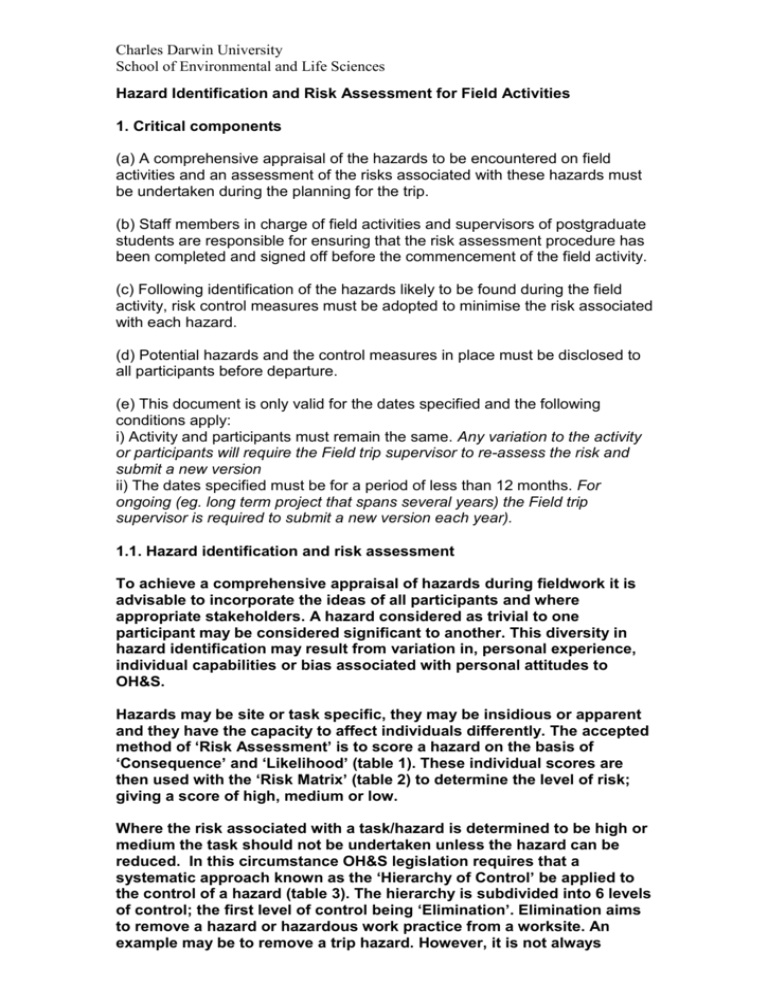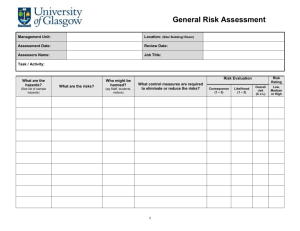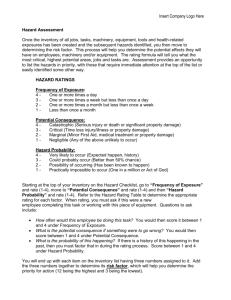Hazard Identification and Risk Assessment for Field Activities
advertisement

Charles Darwin University School of Environmental and Life Sciences Hazard Identification and Risk Assessment for Field Activities 1. Critical components (a) A comprehensive appraisal of the hazards to be encountered on field activities and an assessment of the risks associated with these hazards must be undertaken during the planning for the trip. (b) Staff members in charge of field activities and supervisors of postgraduate students are responsible for ensuring that the risk assessment procedure has been completed and signed off before the commencement of the field activity. (c) Following identification of the hazards likely to be found during the field activity, risk control measures must be adopted to minimise the risk associated with each hazard. (d) Potential hazards and the control measures in place must be disclosed to all participants before departure. (e) This document is only valid for the dates specified and the following conditions apply: i) Activity and participants must remain the same. Any variation to the activity or participants will require the Field trip supervisor to re-assess the risk and submit a new version ii) The dates specified must be for a period of less than 12 months. For ongoing (eg. long term project that spans several years) the Field trip supervisor is required to submit a new version each year). 1.1. Hazard identification and risk assessment To achieve a comprehensive appraisal of hazards during fieldwork it is advisable to incorporate the ideas of all participants and where appropriate stakeholders. A hazard considered as trivial to one participant may be considered significant to another. This diversity in hazard identification may result from variation in, personal experience, individual capabilities or bias associated with personal attitudes to OH&S. Hazards may be site or task specific, they may be insidious or apparent and they have the capacity to affect individuals differently. The accepted method of ‘Risk Assessment’ is to score a hazard on the basis of ‘Consequence’ and ‘Likelihood’ (table 1). These individual scores are then used with the ‘Risk Matrix’ (table 2) to determine the level of risk; giving a score of high, medium or low. Where the risk associated with a task/hazard is determined to be high or medium the task should not be undertaken unless the hazard can be reduced. In this circumstance OH&S legislation requires that a systematic approach known as the ‘Hierarchy of Control’ be applied to the control of a hazard (table 3). The hierarchy is subdivided into 6 levels of control; the first level of control being ‘Elimination’. Elimination aims to remove a hazard or hazardous work practice from a worksite. An example may be to remove a trip hazard. However, it is not always Charles Darwin University School of Environmental and Life Sciences practicable or possible to eliminate a hazard and therefore the next control, ‘Substitution’ can be applied. An example of substitution may be changing from using a toxic chemical to a non toxic alternative. Skipping forward to the final level of control; Personal Protective Equipment (PPE) is considered the lowest, least effective, control because it assumes that the employee involve in a task will be exposed to some level of risk. Where long term exposure is likely PPE may not be sufficient in mitigating risks to employees. Table 1, Defining categories of Consequence and Likelihood Consequence Description Likelihood Description Major Death or extensive Injury A Is expected to occur Moderate Medical treatment B Could probably occur Minor First aid treatment C Could occur but only rarely Insignificant No treatment D May occur but probably never will (Derived from Safe work procedure worksheet) Table 2, Risk Matrix combining elements of Consequence and Likelihood Likelihood Consequence Major Moderate Minor Insignificant A H H H M B H H M M C H M M L D M M L L (Derived from Safe work procedure worksheet) Charles Darwin University School of Environmental and Life Sciences Table 3, Hierarchy of control 1. Elimination 2. Substitution 3. Isolation 4. Redesign 5. Administration 6. Personal Protective Equipment Example Remove the hazard Asbestos remove it from the building Use an alternative use scaffolding rather that ladders quieter machinery for noisy models Separation of hazard place a physical barrier around the hazard to exclude access separate vehicle and foot traffic in warehouses Change the process or equipment so that the hazard is avoided Change the work practice require employees involved in hazard processes to have certain rest periods, e.g. truck drivers Provide protective clothing and or equipment. (Derived from Safe work procedure worksheet) 2. Incident reporting, investigation and recording (a) Before commencement of the field activity, the staff member in charge must be familiar with the Charles Darwin University policy on Incident Reporting, Investigation and Recording Procedures (b) An Accident,Injury,Incident Report must be completed for all incidents, no matter how minor. The supervisor of the group or the staff member in charge of the field activity should undertake an investigation of the incident on site and assist with the completion of the incident report form. A thorough investigation of the immediate and underlying causes of an incident is essential to prevent a recurrence. (c) Completed incident forms must be sent to CDU Health, Safety and Environment department upon return from the field activity. (d) The presence of any disturbing or suspicious people at study sites should be reported immediately both to a specified departmental contact person and to the police. Charles Darwin University School of Environmental and Life Sciences HAZARD CHECKLIST Possible source/agent Initial risk level before control measures Low, Med, High or N/A Temperature Fire Hot environment Cold environment Other____________________ Water or Immersion in Boating Swimming Diving Collecting or travelling near water bodies Other____________________ Stress Cutting, stabbing, puncturing Thermal – heat Thermal - cold Repetitive activity/motion Other____________________ Blades/knives Sharpened tools Equipment Environment (eg. thorny bushes)___________________ Other (specify) RISK CONTROL measure MUST BE FILLED IN IF THERE IS ANY RISK Final risk level Charles Darwin University School of Environmental and Life Sciences Allergies and allergic reactions (specify) Chemical_________________ Animal___________________ Food____________________ Other__________________ Hygiene Food preparation Food storage Personal (eg , cleaning and toilet facilities) ________________________ Other__________________ Entanglement Rope/wires Grass Clothing Other___________________ Slipping, tripping and falling Rope/wires Uneven surface Wet environment/surface Muddy environment/surface Working at heights/ladder use Tree climbing Other___________________ Site specific Animal hazards unrelated to trapping Bites Stings Other (specify species if known and identified hazard) Charles Darwin University School of Environmental and Life Sciences Common Name- Scientific Name Animals trapping or study where direct contact is expected Electrical Chemicals (specify) Pressurised vessels or equipment (includes compressed air and gas bottles) Permit No. Hazards identified Power generation equipment Plant and Equipment High Voltage Other___________________ Handling and use Transport Storage Name of chemical(s)_______________ __________________________ __________________________ Handling and use Transport Storage Name of gas(es)__________________ __________________________ Charles Darwin University School of Environmental and Life Sciences Vehicles, plant and machinery Four wheel drive Quad bike Boat Trailer Bus Heavy vehicle__________________ Scientific equipment Motorised equipment Pressure equipment Conveyors Sampling equipment Other____________________ __ Radiation Ionising source Non-ionising source Plant and Equipment (laser) Electromagnetic Ultraviolet (lamps/solar) Other____________________ ____ Vibration Crushing Plant and Equipment Environment (eg earthquake) Other____________________ ____ Equipment Plant Environment (eg rock fall)_______________________ ____ Other____________________ ____ Charles Darwin University School of Environmental and Life Sciences Noise Inhalation Plant and Equipment Vehicle___________________ Environment_______________ Other____________________ Fumes Smoke Dust Welding vapours Chemicals (specify)__________________ _________________________ Suffocation Tunnels Avalanches Land slippage Confined space Other____________________ Struck by or striking against Plant and Equipment Vehicle Lightning Environment (eg rock fall, tree branch)____________________ ____ Other____________________ ____ Other factors Charles Darwin University School of Environmental and Life Sciences Completed by: (Name) Date: Completed by: (Signature) Date: Signed: (Laboratory Manager) Date: Signed: (SELS Head of School or delegate) Date: NOTE: This form is approved only when all signatures have been obtained.






